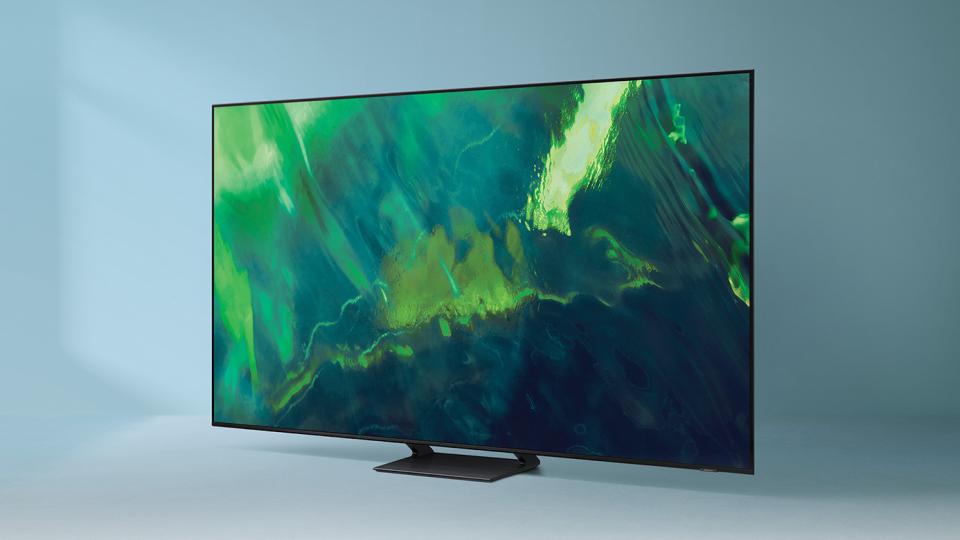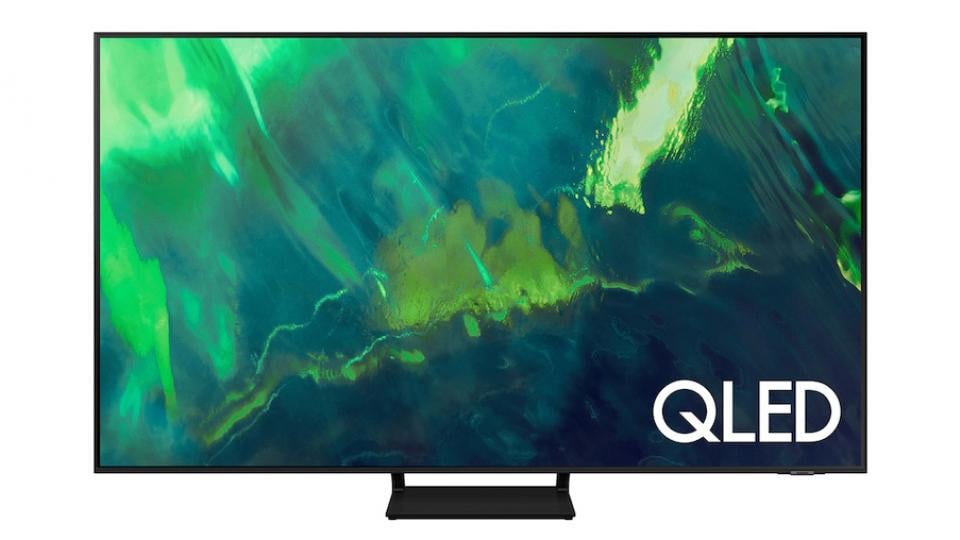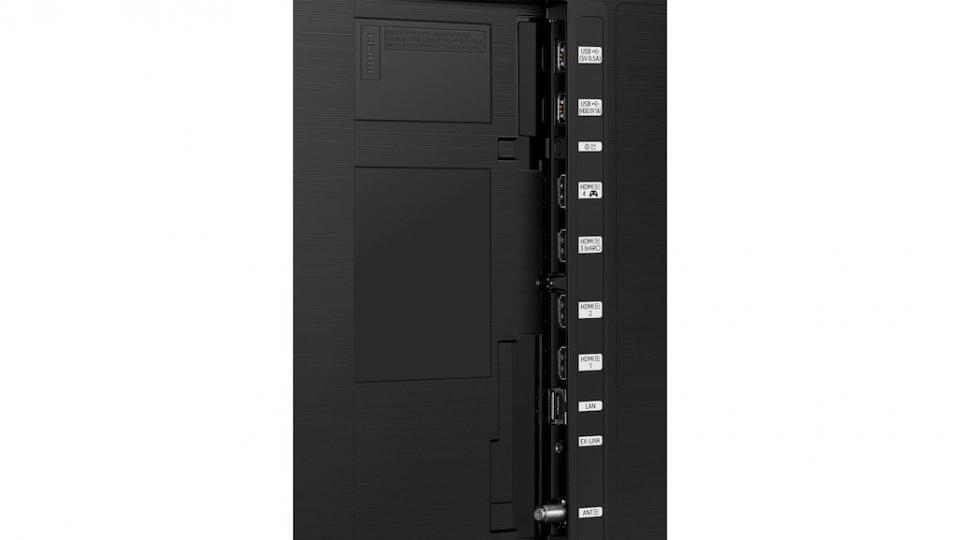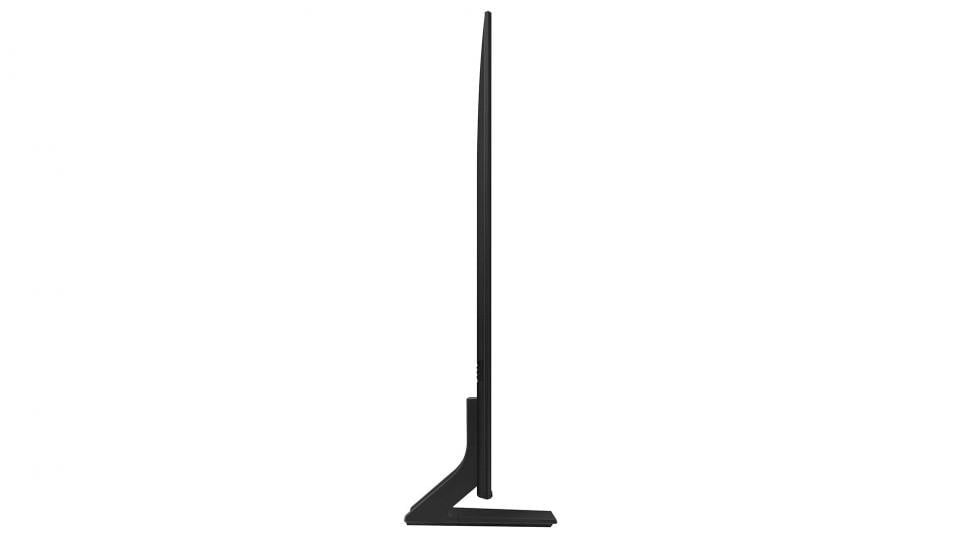
The Q70A QLED aims to hit the perfect balance of price and performance
Pros Fast response timesVRR including FreeSyncHDR10, HLG and HDR10+Cons Lacks local dimmingOnly one HDMI 2.1 port
The mid-range model in Samsung’s 2021 4K QLED line-up, the Q70A is an elegant looking 4K option with a whole raft of features for home cinema, TV and gaming addicts alike. It’s also a considerably less expensive option than any of Samsung’s recently released Neo QLED Mini LED range.
What Samsung calls AirSlim, the Q70A has a depth of just 27mm and a bezel that measures just 12mm. It’s almost all-screen, making it perfect for popping on the wall, but if wall-mounting isn’t an option it also comes with a perfectly functional centre-mounted stand that allows it to be positioned pretty much anywhere, so there’s ample flexibility on that score.
While the design is important, it’s nowhere near as crucial as performance. In the Q70A, Samsung has tried to create a TV that pleases all comers, whether they be movie buffs or next-gen gaming fanatics. So, does the Q70A, a TV that’s still within the realms of affordability for most people, really cover all the bases?
Samsung Q70A: Key specifications |
|
| Screen sizes available: | 55in QE55Q70AATXXU, 65in QE65Q70AATXXU, 75in QE75Q70AATXXU, 85in QE95Q70AATXXU, |
| Panel type: | VA-type QLED, edge-lit |
| Resolution: | 4K/UHD (3840 x 2160) |
| Refresh rate: | 120Hz |
| HDR formats: | HDR, HDR10+, HLG |
| Audio enhancement: | OTS Lite, Dolby 5.1 Decoder, Q-Symphony |
| HDMI inputs: | 3 x HDMI 2.0, 1 x HDMI 2.1 |
| Streaming services: | Netflix, Amazon Prime Video, Now, Apple TV+, Freeview Play etc. |
| Tuners: | DVB-T2/S2/C |
| Gaming features: | 4K at 120Hz, VRR, ALLM |
| Wireless connectivity: | Wi-Fi 802.11ac, Bluetooth 4.2 |
| Smart assistants: | Samsung Bixby, Google Assistant, Amazon Alexa |
| Smart platform: | Tizen OS 6.0 |
Samsung Q70A: What you need to know
Samsung was quite low-key on its TV tech innovation last year, so it’s clearly keen to make up for that in 2021. The Q70A is proof of that, coming packed to the brim with upgraded internals and all-new features.
At its heart sits Samsung’s latest Quantum Processor 4K, a powerful chipset that automatically adjusts the brightness and upscales the resolution of whatever content you’re watching to impressively detailed 4K. The Quantum Processor also optimises audio, regardless of source, to bring you an all-around more immersive experience.
Next up – and of particular interest to PS5 and Xbox Series X owners – the Q70A’s panel has a refresh rate of 120Hz and is capable of delivering 120fps on a 4K signal. If that wasn’t enough, it’s imbued with a new feature called ‘Motion Xcelerator Turbo+’ that enhances motion clarity for incredibly smooth, crisp gameplay, plus it supports FreeSync variable refresh rate (VRR) and promises an impressively low input lag, all combining to deliver a premium next-gen gaming experience for a mid-range price. ALLM (Auto Low-Latency Mode) is also on hand to boot the TV into a low-input Game mode when next-gen consoles are connected. The catch? There’s only one HDMI 2.1 input.
The Q70A is certainly no slouch when it comes to cinematics, either. Firstly, the Quantum Dot part of its designation sees Samsung sandwich a layer of nanoparticles between the panel and the Dual LED backlight, boosting both brightness and the colour gamut beyond what you could hope to see from a conventional LCD panel.
HDR10 and HLG are nice to have, but it’s the HDR10+ support that’s most important. This HDR format enhances images by fine-tuning the brightness in each and every scene to eke out the smallest details that might otherwise be lost to dark shadows or specular highlights. And if your Q70A resides in a room with variable ambient light (as most will), the TV’s adaptive brightness can automatically adjust contrast and brightness to suit the environment, keeping your 4K HDR movies looking impactful.
So, the picture and gaming credentials are there. But how is the sound? There’s a lot of heavy lifting to be done here for the audio to equal the images, but Samsung has done its best. Two internal speakers produce 20W of sound, while an active voice amplifier automatically amplifies dialogue when it detects other audible interference, which may assist with the incessant mumbling that seems to persist across every new crime drama that hits our screens.
On top of this is Samsung’s OTS (Object Tracking Sound) which features in all of its 2021 TV line-up. As the Q70A sits at the lower end of range, it gets OTS Lite instead (it’s determined by the number of speakers). With OTS, the two downward-firing speakers work in conjunction with two ‘virtual’ upward-firing speakers to widen the soundscape and give the impression that the audio is able to follow objects on the screen.
Unfortunately, but not unexpectedly, Samsung forgot to bring the bass, which is an essential part of any self-respecting home cinema. Obviously, this bass deficiency can be easily rectified with the addition of a soundbar – something Samsung has more than pre-empted with its 2021 Q-series and A-series soundbar range.
On the smart front, the Q70A runs the latest version of Tizen OS (6.0 at launch), instantly allowing access to all the usual streaming suspects, such as Netflix, Amazon Prime Video, Apple TV, Disney Plu and HBO Max, plus countless others. And if you’re at all indecisive as to your preferred voice assistant, the Q70A offers three: Samsung’s Bixby, Amazon’s Alexa and Google Assistant.
Add to all that a ‘Multi-View’ function that lets you split the screen to watch two things simultaneously, plus a solar-powered remote control and the Samsung 4K QLED Q70A is an impressive-looking TV that’s got all the bases covered, from movies to gaming. Okay, the stock sound is not going to blow you away, so extra expense on a decently specced soundbar will be required, but other than that, the Samsung Q70A proves you can get most of the bells and whistles of a modern 4K HDR smart TV without breaking the bank.
Samsung Q70A: Price and competition
With an entry cost of just £1,200 for the 55in option and £1,500 for the 65in, the Q70A is priced rather competitively, although the prices do rise steeply for the 75in and 85in sizes. For the big-screen 85in monster you’ll have to fork over £3,500.
With that said, at Expert Reviews we like to ensure you have options, so perhaps you might consider the Sony X90J LED TV instead? Available in 50in, 55in, 65in, and 75in sizes with pricing that’s comparable to the Samsung Q70A range, the X90J is a 4K Full-Array LED featuring HDR10, Dolby Vision and HLG. It boasts Sony’s Contrast Booster 5, Acoustic Multi-Audio, Dolby Atmos and 3D Surround upscaling. And for the gamers there are two HDMI 2.1 ports supporting 4K@120Hz, ALLM and VRR. Priced at £1400 at John Lewis for the 55in iteration, it’s certainly worth sounding out despite the extra cost over the Q70A.
Then there is, for a bit of a price jump, LG’s exceptional new LG B1 4K OLED TV. The B1 promises offers incredible contrast, 100% colour fidelity and impressive upscaling courtesy of LG’s α7 Gen4 AI processor. And then there’s its 4K@120Hz and VRR support (across two HDMI 2.1 inputs), Game Optimiser mode, Dolby Vision IQ, Dolby Atmos and 40W of 2.2 channel audio. Retailing at £1600 at John Lewis for the 55in, it may be £400 more than the Samsung, but you may be able to get away with not buying a soundbar to go with it.



